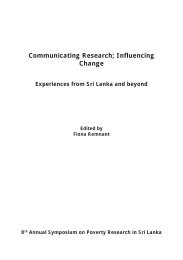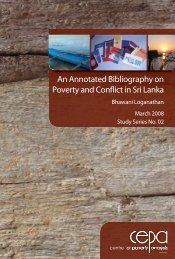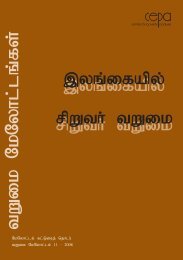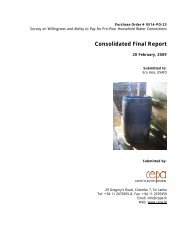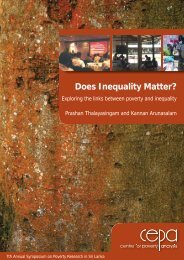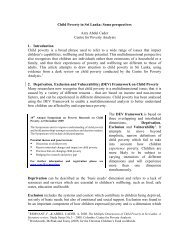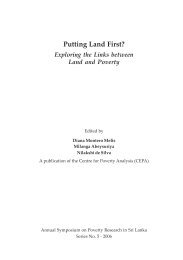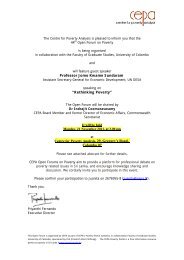Involuntary Displacement and Resettlement â Policy and ... - CEPA
Involuntary Displacement and Resettlement â Policy and ... - CEPA
Involuntary Displacement and Resettlement â Policy and ... - CEPA
- No tags were found...
You also want an ePaper? Increase the reach of your titles
YUMPU automatically turns print PDFs into web optimized ePapers that Google loves.
6 Current Situation <strong>and</strong> Recent Developments inLivelihood RestorationMost of the post tsunami livelihood programs were focused on providing cashfor work, grants to start a small business or alternative livelihood trainingprogrammes <strong>and</strong> little attention was paid to the fisheries sector. Livelihoodprogrammes focused on the fisheries sector were rare, with only some fisherhouseholds in Trincomalee (in Salli, Kuchchaveli <strong>and</strong> Annal Nagar areas)receiving training in boat repair. As the fishers had a great loss of physicalassets such as boats, nets <strong>and</strong> fishery infrastructure, programmes were mainlyconfined to the provision of boats <strong>and</strong> fishing tools rather than implementationof a well planned, coordinated <strong>and</strong> holistic livelihood restoration. There wereefforts by the government, local <strong>and</strong> international NGOs <strong>and</strong> other donors torehabilitate the fisheries sector by providing livelihood assets to the affectedcommunity. Due to lack of appropriate data <strong>and</strong> poor coordination, differinginterests <strong>and</strong> priorities of donors <strong>and</strong> the inefficiency of governmentinstitutions, the rehabilitation of the sector is currently facing serious problems.Poor targeting has resulted in conflict, as in many cases the beneficiaries werenot genuine, with some of the genuine beneficiaries yet to receive livelihoodassets. Unplanned supply of more fishing craft has aggravated the competitionamong coastal fishers, resulting in low catch per unit effort.According to the Census of Boats conducted in 2006/2007 by the Ministry ofFisheries <strong>and</strong> Aquatic Resources (MFAR), the fishing fleet has increased by35% from 2004 to 2007 (MFAR, 2007). The MFAR thinks that the over supplyof boats by tsunami rehabilitation programmes may result in theover-exploitation of coastal fisheries (MFAR, 2006). The follow-up surveyresults revealed that most fishers observed that the fish catch rate per crafthas dropped. Over supply of fishing craft increases the total fishing effort,thereby threatening certain vulnerable fisheries with depletion of stocks. Itcould lead to a decrease in the income of individual small scale fishers, furthermarginalising poorer sections of the community. This situation is aggravatedby increases in fuel prices <strong>and</strong> coastal fishery in Sri Lanka may have reached apoint where implementation of strong <strong>and</strong> effective measures of managementcannot be delayed any further.In addition to the above-mentioned factors, fishers in the Trincomalee districtface other constraints due to the prevailing security situation, such as restrictionon fishing time (night time fishing not allowed), restrictions on fishing area <strong>and</strong>the prohibition of motorised boats of above a certain engine power.97



